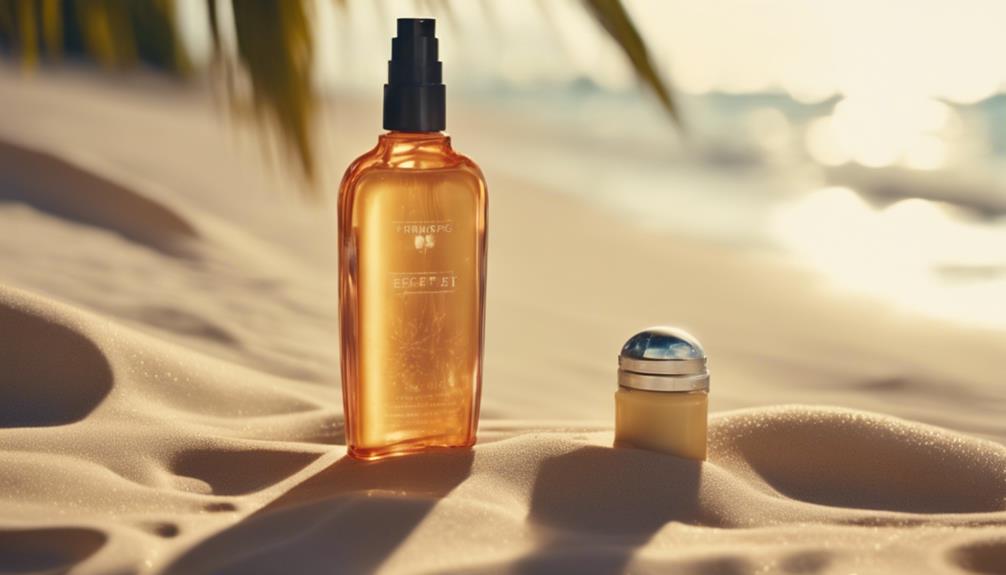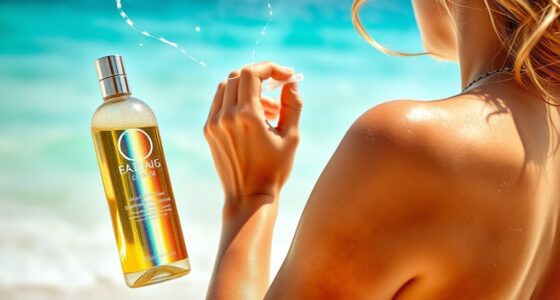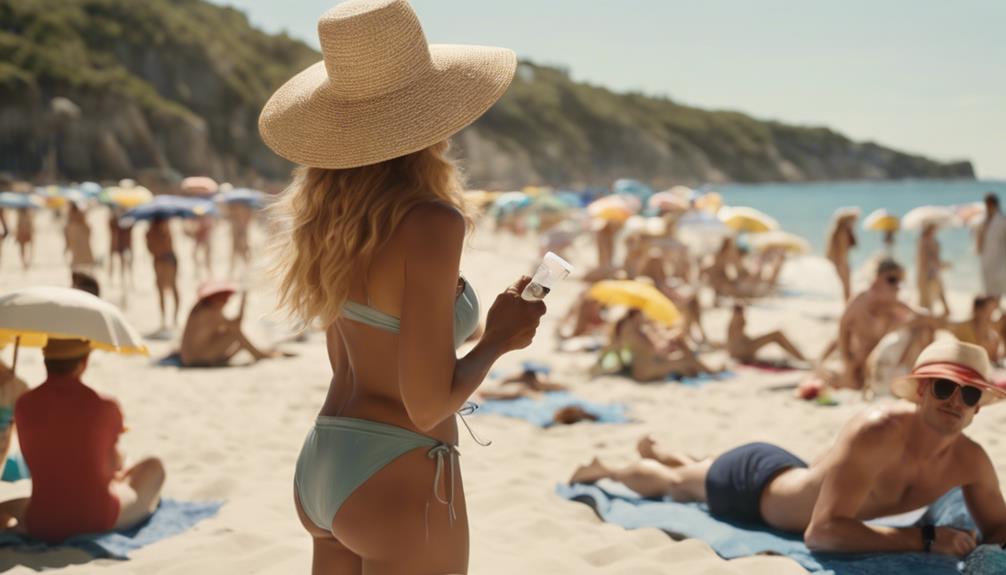One simple change that can save your skin this summer is applying broad-spectrum sunscreen daily. A sunscreen with at least SPF 30 protects against harmful UVA and UVB rays. Reapply it every two hours, especially after swimming or sweating. Don't forget areas like your ears, neck, and hands, which often get overlooked. Hydrating and choosing lightweight moisturizers can also enhance your skin's resilience. Remember, protecting your skin is key for a healthier glow. If you want tips on maintaining ideal skin health, there's plenty more to explore.
Key Takeaways
- Apply broad-spectrum sunscreen with SPF 30+ every two hours to protect against harmful UV rays.
- Stay hydrated by drinking at least 104 ounces of water for men and 72 ounces for women daily.
- Incorporate hydrating foods like cucumbers and watermelon into your diet for skin moisture.
- Use lightweight, water-based moisturizers right after cleansing to lock in hydration.
Importance of Sunscreen
Sunscreen is essential for anyone looking to protect their skin from harmful UV rays and prevent premature aging. Using a broad-spectrum sunscreen with an SPF of 30 or higher is critical because it shields your skin from both UVA and UVB rays, which can lead to skin concerns like wrinkles and increased risk of skin cancer.
Don't forget to reapply it every two hours, especially after swimming or sweating, to maintain effective sun protection throughout the day. Even on cloudy days, up to 80% of UV rays can still reach your skin, so daily application is a must, no matter the weather.
Pay attention to areas often overlooked during application, such as your ears, neck, hands, and lips. These spots are just as vulnerable to sun damage and deserve protection too.
If you're using retinoids or have sensitive skin, be extra vigilant. These products can heighten your skin's sensitivity to UV exposure, making sunscreen even more essential.
Benefits of Protective Clothing

Wearing protective clothing can greatly enhance your defense against harmful UV rays and reduce the risk of skin damage. When you're out in the sun, consider these benefits of choosing the right attire for protecting your skin:
- Blocks UV Rays: Lightweight, sun-protective clothing can block up to 98% of harmful UV rays, keeping your skin safe.
- Sensitive Areas Covered: Long sleeves and pants made from tightly woven fabrics protect sensitive skin areas where you mightn't apply sunscreen.
- Color Counts: Dark-colored clothing offers higher SPF protection than lighter colors, providing a better physical barrier against UV exposure.
- Specialized Fabrics: UV-blocking fabrics come with an Ultraviolet Protection Factor (UPF) rating, ensuring maximum safety.
Hydration Strategies for Summer

To keep your skin healthy this summer, focus on your hydration strategies.
You should aim to drink plenty of water daily, incorporate hydrating foods into your meals, and apply a good moisturizer regularly.
These simple steps can make a big difference in your skin's comfort and appearance.
Daily Water Intake
Staying properly hydrated during the summer months is essential for maintaining healthy skin and overall well-being. Your daily water intake plays a vital role in hydration, especially in the heat.
Here are four strategies to help you stay on track this summer:
- Set Daily Goals: Aim for at least 104 ounces for men and 72 ounces for women. Adjust these amounts if you're active outdoors.
- Start Your Day Right: Drink a glass of water first thing in the morning to kickstart your hydration.
- Use a Reusable Water Bottle: Keep a water bottle handy as a reminder to sip throughout the day. It's a simple way to stay accountable!
- Monitor Your Hydration: Pay attention to your body. If you feel thirsty or your skin appears dry, it's time to drink more water.
Hydrating Foods Benefits
Incorporating hydrating foods into your diet can greatly boost your skin's moisture levels and overall hydration during the hot summer months. Foods like cucumbers and watermelon are packed with water, which helps quench your thirst while enhancing skin moisture levels. These fruits and veggies typically contain around 90% water, making them perfect for summer snacking.
Additionally, hydrating foods provide essential vitamins and antioxidants that support skin health. Including Omega-3 fatty acids from sources like flaxseeds and walnuts in your diet can further aid in maintaining your skin's lipid barrier, preventing moisture loss. This contributes to a healthy glow that you'll love to show off during sunny days.
Don't forget that while you sip on water, your food choices play an important role in your hydration strategy. Eating a balanced diet filled with hydrating foods can improve skin elasticity and reduce the risk of dryness and irritation caused by the summer heat.
Moisturizer Application Techniques
Applying lightweight, water-based moisturizers is essential for keeping your skin hydrated and comfortable during the hot summer months.
Here are some effective moisturizer application techniques to enhance your summer skincare routine:
- Moisturize Right After Cleansing: Apply your moisturizer while your skin is still damp to lock in maximum hydration. This simple step boosts moisture retention and supports skin health.
- Choose Hydrating Ingredients: Look for products with hyaluronic acid and ceramides. These ingredients help combat the drying effects of sun exposure and air conditioning, ensuring your skin stays supple.
- Incorporate SPF: Opt for a moisturizer that includes sun protection. This way, you'll hydrate your skin while safeguarding it from harmful UV rays throughout the day.
- Reapply Regularly: Don't forget to reapply your moisturizer in the afternoon, especially if you're outdoors. Regular applications combat moisture loss and keep your skin feeling comfortable.
Gentle Cleansing Techniques

Cleansing your skin daily is essential, especially in the summer heat when sweat and impurities build up.
You'll want to choose the right type of cleanser—foaming or gel-based options work best without stripping your skin's natural oils.
Remember to use cold or room-temperature water to avoid irritation and keep your skin feeling fresh and comfortable.
Importance of Daily Cleansing
Daily cleansing plays an essential role in maintaining skin health, especially during the summer when sweat and impurities can lead to breakouts and irritation.
By incorporating a daily cleansing routine, you can effectively keep your skin balanced and refreshed.
Here are some key skincare tips to take into account:
- Use a gentle cleanser: Opt for a product that removes excess oil without stripping your skin's natural moisture.
- Cleanse 1-2 times daily: Regular cleansing helps eliminate grime and prevent clogged pores, especially after sweating.
- Avoid hot water: Rinse your face with cool or room-temperature water to avoid irritation and maintain your skin's barrier.
- Enhance product effectiveness: Cleansing prepares your skin for better absorption of other skincare products, maximizing their benefits.
Best Cleanser Types
Choosing the right cleanser can make a significant difference in how your skin feels and looks, especially during those hot summer months. The best cleanser types for summer are foaming or gel-based cleansers, which effectively remove sweat and impurities while maintaining your skin's natural oils. It's important to cleanse your face 1-2 times daily to keep your skin clear and comfortable.
To help you choose the right cleanser, here's a quick comparison:
| Cleanser Type | Benefits | Ideal For |
|---|---|---|
| Foaming Cleanser | Removes sweat and impurities | Oily/Combination Skin |
| Gel Cleanser | Lightweight, invigorating feel | Normal/Sensitive Skin |
| Cream Cleanser | Hydrating, nourishes dry skin | Dry/Sensitive Skin |
Using cold or room-temperature water can also aid in preventing irritation and dryness, especially for sensitive skin types. Pairing your cleanser with a light moisturizer helps achieve ideal skin balance, ensuring hydration without heaviness. Regular cleansing is essential for preventing clogged pores and breakouts during the hot summer, so choose wisely and keep your skin glowing!
Avoiding Skin Irritation
Gentle cleansing techniques are essential for keeping your skin calm and irritation-free, especially during the heat of summer. With increased sweat and humidity, you need to adapt your cleansing routine to protect your sensitive skin.
Here are some key strategies to help you avoid irritation:
- Choose the Right Cleanser: Opt for foaming or gel-based cleansers that effectively remove dirt without stripping essential oils.
- Use Cool Water: Rinse your face with cold or room-temperature water to prevent irritation and dryness.
- Pat, Don't Rub: After cleansing, gently pat your skin dry with a soft towel instead of rubbing, reducing the risk of irritation.
- Moisturize Lightly: Follow up with a light moisturizer to maintain hydration and promote ideal skin balance.
Incorporating Antioxidants

Incorporating antioxidants into your skincare routine can dramatically enhance your skin's health and appearance, providing essential protection against environmental stressors. Antioxidants, such as Vitamin C and E, are crucial in combating oxidative stress caused by UV radiation, which can lead to premature aging. By adding Vitamin C serum to your daily regimen, you'll boost collagen production, improving skin elasticity and reducing fine lines.
Here's a quick overview of some key antioxidants you can include:
| Antioxidant | Benefits | Application Tips |
|---|---|---|
| Vitamin C | Boosts collagen, reduces fine lines | Use in the morning |
| Niacinamide | Brightens skin, evens out tone | Apply daily for best results |
| Resveratrol | Reduces inflammation, combats hyperpigmentation | Layer under moisturizer |
| Vitamin E | Protects against UV damage, hydrates skin | Mix with your favorite cream |
| Green Tea | Soothes skin, provides anti-aging benefits | Use in serums or toners |
Regular use of these antioxidants can greatly improve your skin resilience, ensuring you look radiant and youthful all summer long. Don't miss out on this simple yet effective change!
Managing Sweat and Oil

Managing sweat and oil during the hotter months is essential for keeping your skin clear and comfortable. Excess sweat and oil can lead to breakouts, so here are some effective strategies to help you manage them:
- Change Clothes Promptly: Quickly changing out of sweaty clothes reduces the risk of trapped sweat and oil irritating your skin.
- Opt for Lightweight Fabrics: Wearing breathable cotton clothing helps manage sweat and enhances your skin's comfort during hot weather.
- Wash Accessories Regularly: Make sure to regularly wash hats and other accessories to prevent buildup of oil and sweat that can irritate your skin.
- Monitor Environmental Triggers: Pay attention to how chlorine, saltwater, and sand affect your skin during summer activities, as these can exacerbate issues.
Choosing Lighter Skincare Products

As the temperature rises, it's time to rethink your skincare routine.
Choosing lighter formulas, like water-based moisturizers and gel cleansers, helps keep your skin hydrated without the heaviness that can lead to breakouts.
Shifting to these summer-friendly products can enhance your skin's comfort and resilience, ensuring you look fresh all season long.
Benefits of Lightweight Formulas
Switching to lightweight formulas can transform your skincare routine by providing hydration without the heaviness that often clogs pores. During the summer months, it's essential to adapt your products to keep your skin healthy and fresh.
Here are four key benefits of using lightweight formulas:
- Enhanced Hydration: Lightweight, water-based moisturizers deliver essential hydration without the oily residue, perfect for hot days.
- Quick Absorption: These products absorb quickly, leaving your skin feeling refreshed and non-greasy, which helps regulate oil production and prevents breakouts.
- Reduced Clogging: By opting for gel-based cleansers and serums, you minimize the risk of clogged pores, even in humid conditions.
- Natural Finish: Tinted moisturizers and lightweight foundations give you a natural look while preventing makeup from melting, so you can enjoy your day without worry.
Transitioning to Summer Products
Adapting your skincare routine for summer means choosing lighter products that keep your skin hydrated and vibrant without the weight of heavy creams. As humidity levels rise, switching from thick moisturizers to lightweight, water-based options will help you maintain hydration without clogging your pores.
Gel-based cleansers are perfect for summer, as they effectively remove sweat and impurities while providing a revitalizing feel, avoiding the dryness that harsher products can cause.
Incorporating lightweight serums with hydrating ingredients like hyaluronic acid is another great move. These serums retain moisture without leaving a greasy finish, making them ideal for warm weather.
When it comes to makeup, opt for tinted moisturizers and translucent powders—they offer coverage while allowing your skin to breathe, considerably reducing the risk of breakouts during those hot summer days.
Regularly evaluating your skincare routine guarantees your products align with your skin's needs in warmer temperatures. This proactive approach can help prevent issues like excess oil production and irritation, allowing you to enjoy summer with confidence and glowing skin.
Cooling Ingredients for Relief

Cooling ingredients like aloe vera and cucumber extract can provide instant relief for sunburned or irritated skin, making them essential in your summer skincare routine. These powerful components not only soothe sunburned skin but also enhance hydration and boast anti-inflammatory properties.
Here are four key cooling ingredients to incorporate:
- Aloe Vera: Known for its hydrating abilities, it calms and cools irritated skin.
- Cucumber Extract: This ingredient hydrates and rejuvenates, leaving your skin feeling revitalized.
- Menthol: Found in many lotions, menthol creates a cooling sensation that reduces skin temperature.
- Green Tea: Packed with antioxidants and anti-inflammatory properties, it helps protect and calm your skin.
Using gel-based moisturizers infused with these cooling ingredients can enhance skin comfort without the heaviness of traditional creams.
You might also consider chilled skincare products, like refrigerated mists and serums, to deliver an invigorating burst of hydration.
Maintaining Skin Health

While soothing ingredients can provide immediate relief, maintaining skin health requires an extensive approach that focuses on hydration and proper skincare routines.
Staying hydrated is vital, so aim for at least 104 ounces of water daily if you're male and 72 ounces if you're female. This helps support skin elasticity and combat dryness.
Incorporate lightweight moisturizers with hydrating ingredients like ceramides and hyaluronic acid into your routine, especially during summer when humidity levels fluctuate. Regular cleansing with foaming or gel-based cleansers is fundamental too. It effectively removes sweat and impurities while preventing clogged pores and maintaining skin clarity.
Don't forget to apply sunscreen every day, even when it's cloudy. It protects your skin from UV damage and helps preserve its health. Also, integrating antioxidants like Vitamin C and Niacinamide can boost your skin's resilience against environmental stressors and sun exposure.
Lastly, adjust your skincare routine to include regular exfoliation. This helps prevent clogged pores and improves overall skin texture, making your skin look refreshed and healthy.
Tips for Outdoor Activities

When you're heading outdoors, protecting your skin from the sun's harmful rays is essential for maintaining its health. Here are some tips to help you enjoy your time outside while keeping your skin healthy:
- Apply sunscreen with SPF 30+ every two hours, even on cloudy days, to shield against UVB rays that can damage your skin.
- Wear lightweight, UV-protective clothing, such as long sleeves and wide-brimmed hats, to protect your face and sensitive areas from direct sun exposure.
- Stay hydrated by drinking at least 72 ounces of water daily for women and 104 ounces for men. Proper hydration helps combat dehydration from sun exposure and keeps your skin healthy.
- Schedule outdoor activities during cooler parts of the day, ideally early morning or late afternoon. This minimizes your exposure to the sun when UV rays are strongest between 10 AM and 2 PM.
Frequently Asked Questions
How Can I Save My Skin in Summer?
To save your skin in summer, apply broad-spectrum sunscreen regularly, stay hydrated, use lightweight moisturizers, incorporate antioxidants, and cleanse your face daily. These steps will help maintain your skin's health and appearance.
How to Protect Skin in Hot Weather?
You might think sweating is your skin's best friend, but it's not! Protect your skin in hot weather by applying broad-spectrum sunscreen, wearing UV-blocking clothing, and staying hydrated to maintain that youthful glow.
How Does Your Skin Change in Summer?
In summer, your skin becomes oilier and sweatier, making breakouts more likely. Increased sun exposure can cause sunspots and premature aging, while heat may irritate sensitive skin, requiring adjustments in your skincare routine.
How Should I Change My Skincare for Summer?
How can you keep your skin fresh this summer? Switch to lighter, water-based moisturizers, use gel cleansers, apply SPF 30 or higher, and incorporate antioxidants. These changes help maintain hydration and protect against the sun's harmful effects.
What Simple Change Can I Make to Protect My Skin During Summer?
During the summer, using a beach sand exfoliant can help protect your skin. Gently scrubbing away dead skin cells can prevent clogged pores and breakouts. It also promotes better absorption of moisturizers and sunscreen, keeping your skin healthy and protected from the sun’s harmful rays.
Conclusion
So, you thought skipping sunscreen would give your skin a nice summer tan? Ironically, that's the quickest way to a sunburn instead.
Embrace protective clothing, stay hydrated, and swap your heavy creams for lighter products.
Remember, your skin's health shouldn't take a vacation just because it's summer!
By making these simple changes, you can enjoy the sun without the painful aftermath.
After all, who needs a glowing complexion when you can rock the lobster look?









